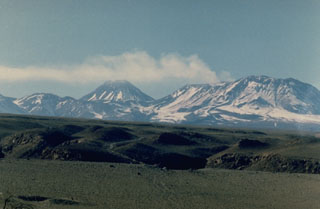Report on Lascar (Chile) — September 2007
Bulletin of the Global Volcanism Network, vol. 32, no. 9 (September 2007)
Managing Editor: Richard Wunderman.
Lascar (Chile) Occasional aviation reports of ash plumes during November 2006-July 2007
Please cite this report as:
Global Volcanism Program, 2007. Report on Lascar (Chile) (Wunderman, R., ed.). Bulletin of the Global Volcanism Network, 32:9. Smithsonian Institution. https://doi.org/10.5479/si.GVP.BGVN200709-355100
Lascar
Chile
23.37°S, 67.73°W; summit elev. 5592 m
All times are local (unless otherwise noted)
Our last Bulletin report on Láscar (BGVN 31:11) discussed minor explosions and ash plumes during September-October 2006, morphological changes in the central active crater since the May 2005 eruption, and an ongoing investigation on fumarolic gases venting in the active crater.
Reports since November 2006 and into late 2007 indicated that Láscar continued to emit ash plumes. On 22 January 2007, based on satellite imagery, the Buenos Aires Volcanic Ash Advisory Center (VAAC) reported continuous emissions from the volcano that drifted NNE. Then, according to the VAAC, on11 March 2007 an ash cloud from Láscar rose to 5.5-6.7 km altitude and drifted E. The VAAC's next report on Láscar indicated that on 23 May, an ash plume from Láscar rose to an altitude of 9.1 km and drifted SSE, based upon a Significant Meteorological Information (SIGMET) advisory and satellite image observations. Finally, the VAAC reported that, based on pilot reports and satellite image observations, on 18 July 2007 an ash plume rose to altitudes of 7.6-9.1 km and drifted NE. We have not seen any activity reports on Láscar between this July report and 23 October 2007, perhaps suggesting an absence of unusually vigorous activity during that interval.
Geological Summary. Láscar is the most active volcano of the northern Chilean Andes. The andesitic-to-dacitic stratovolcano contains six overlapping summit craters. Prominent lava flows descend its NW flanks. An older, higher stratovolcano 5 km E, Volcán Aguas Calientes, displays a well-developed summit crater and a probable Holocene lava flow near its summit (de Silva and Francis, 1991). Láscar consists of two major edifices; activity began at the eastern volcano and then shifted to the western cone. The largest eruption took place about 26,500 years ago, and following the eruption of the Tumbres scoria flow about 9000 years ago, activity shifted back to the eastern edifice, where three overlapping craters were formed. Frequent small-to-moderate explosive eruptions have been recorded since the mid-19th century, along with periodic larger eruptions that produced ashfall hundreds of kilometers away. The largest historical eruption took place in 1993, producing pyroclastic flows to 8.5 km NW of the summit and ashfall in Buenos Aires.
Information Contacts: Buenos Aires Volcanic Ash Advisory Center (VAAC), Servicio Meteorológico Nacional-Fuerza Aérea Argentina, 25 de mayo 658, Buenos Aires, Argentina (URL: http://www.smn.gov.ar/vaac/buenosaires/productos.php).

